当前位置:网站首页>Verilog realizes nixie tube display driver [with source code]
Verilog realizes nixie tube display driver [with source code]
2022-07-07 11:15:00 【Lime Miya】
Catalog
1、 The experiment platform
Software :PC、Quartus Prime 18.1、Modelsim 10.5b
Hardware :Altera FPGA Development board (EP4CE6E22F17C8)
2、 The experiment purpose
- 1、 Master the static display and dynamic refresh of nixie tube
- 2、 Counter exercise
2.1、 Experimental content
Static display 0~F
Dynamic display - Stopwatch design
3、 Experimental process
3.1、 Experimental principle
According to the schematic diagram of the development board , The following information is available
Nixie tube : It is essentially a group of light-emitting diodes arranged in a certain order , Its display principle and LED It's no different .
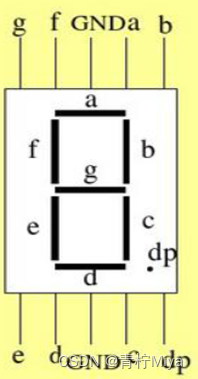
According to the hardware schematic diagram , Light-emitting diode , All anodes are switched on 3.3V Positive voltage of , That is to say — High level , So if we want to
If the LED is on , It is necessary to turn on the low level at the cathode , You can make LED Light up .
3.2、 System architecture
According to the system requirements , The following frame distribution can be obtained
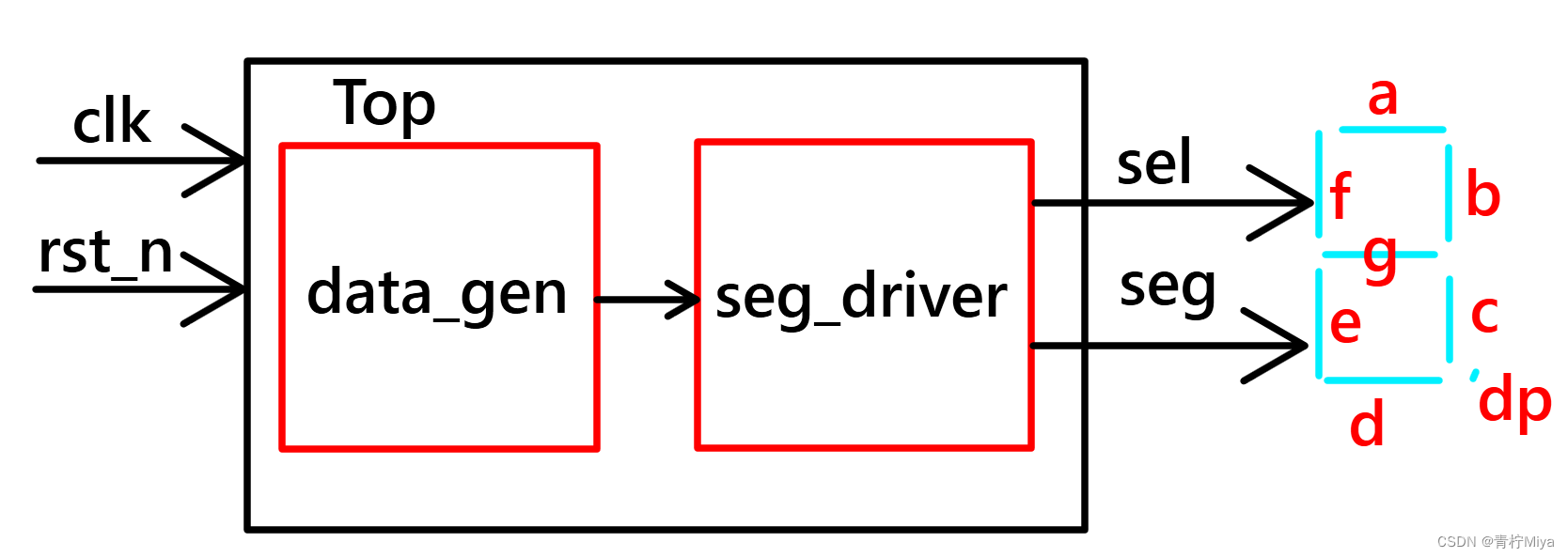
3.3、 Function module division
Build according to the system , The following modules are available
3.3.1、 Data generation module
Block diagram

Signal definition
| Signal name | Port type | Data bit width | Signal description |
|---|---|---|---|
| Clk | i | 1 | Input clock signal ,50MHz |
| Rst_n | i | 1 | Input reset signal , Low level active |
| data_o | O | 32 | Output data to be displayed ,8 Digit nixie tube can display 32 position 16 Hexadecimal data |
Design documents
/*================================================*\ Filename ﹕data_gen.v Author ﹕Adolph Description ﹕ Generate the data that the nixie tube needs to display . 32'h11111111~32'h33333333; Called by ﹕seg_top.v Revision History ﹕ 2022-6-6 15:49:24 Revision 1.0 Email﹕[email protected] Company﹕ \*================================================*/
module data_gen(
input clk ,
input rst_n,
output reg [31:0] data_dis
);
parameter TIME_DELAY = 25'd2500;
reg [24:0] cnt_delay;
[email protected](posedge clk or negedge rst_n)begin
if(!rst_n)begin
cnt_delay <= 25'd0;
end
else if(cnt_delay >= TIME_DELAY - 25'd1)begin
cnt_delay <= 25'd0;
end
else begin
cnt_delay <= cnt_delay + 25'd1;
end
end
[email protected](posedge clk or negedge rst_n)begin
if(!rst_n)begin
data_dis <= 32'h1111_1111;
end
else if(data_dis == 32'h3333_3333)begin
data_dis <= 32'h1111_1111;
end
else if(cnt_delay >= TIME_DELAY - 25'd1)begin
data_dis <= data_dis + 32'h1;
end
else begin
data_dis <= data_dis;
end
end
endmodule
This module is relatively simple , Simulation verification is not done here , If you are interested, you can verify by yourself
3.3.2、 Digital tube driver module
Block diagram

Signal definition
| Signal name | Port type | Data bit width | Signal description |
|---|---|---|---|
| Clk | i | 1 | Input clock signal ,50MHz |
| Rst_n | i | 1 | Input reset signal , Low level active |
| data_in | i | 32 | Input the key debounce signal , High active |
| dig_sel | O | 8 | Digital tube position selection signal , It can be seen from the schematic diagram that , Low level active |
| dig_seg | O | 8 | Select the signal section , It can be seen from the schematic diagram that , Low level active |
Design documents
/*================================================*\ Filename ﹕seg_driver.v Author ﹕Adolph Description ﹕ Decode the input data , And drive the nixie tube to display the corresponding data Called by ﹕seg_top.v Revision History ﹕ 2022-5-30 14:27:22 Revision 1.0 Email﹕[email protected] Company﹕ \*================================================*/
module seg_driver(
input clk ,
input rst_n ,
input [31:0]dis_data,// Data to be displayed
output reg[7:0] dig_sel ,
output reg[7:0] dig_seg
);
//wire [31:0]dis_data;
// assign dig_seg = 8'd0;
// assign dig_sel = 1'b0;
localparam
NUM_0 = 8'hC0,
NUM_1 = 8'hF9,
NUM_2 = 8'hA4,
NUM_3 = 8'hB0,
NUM_4 = 8'h99,
NUM_5 = 8'h92,
NUM_6 = 8'h82,
NUM_7 = 8'hF8,
NUM_8 = 8'h80,
NUM_9 = 8'h90,
NUM_A = 8'h88,
NUM_B = 8'h83,
NUM_C = 8'hC6,
NUM_D = 8'hA1,
NUM_E = 8'h86,
NUM_F = 8'h8E,
LIT_ALL = 8'h00,
BLC_ALL = 8'hFF;
parameter CNT_REF = 25'd1000;
reg [9:0] cnt_20us; //20us Counter
reg [3:0] data_tmp; // It is used to get the display data of different bit selections
// assign dis_data = 32'hABCD_4413;
// Describe bit selection signal switching
// Description refresh counter
[email protected](posedge clk or negedge rst_n)begin
if(!rst_n)begin
cnt_20us <= 25'd0;
end
else if(cnt_20us >= CNT_REF - 25'd1)begin
cnt_20us <= 25'd0;
end
else begin
cnt_20us <= cnt_20us + 25'd1;
end
end
[email protected](posedge clk or negedge rst_n)begin
if(!rst_n)begin
dig_sel <= 8'hfe;//8'b1111_1110
end
else if(cnt_20us >= CNT_REF - 25'd1)begin
dig_sel <= {
dig_sel[6:0],dig_sel[7]};
end
else begin
dig_sel <= dig_sel;
end
end
// Segment selection signal description
[email protected](posedge clk or negedge rst_n)begin
if(!rst_n)begin
data_tmp <= 4'd0;
end
else begin
case(dig_sel)
8'b1111_1110:data_tmp <= dis_data[ 3-:4];
8'b1111_1101:data_tmp <= dis_data[ 7-:4];
8'b1111_1011:data_tmp <= dis_data[11-:4];
8'b1111_0111:data_tmp <= dis_data[15-:4];
8'b1110_1111:data_tmp <= dis_data[19-:4];
8'b1101_1111:data_tmp <= dis_data[23-:4];
8'b1011_1111:data_tmp <= dis_data[27-:4];
8'b0111_1111:data_tmp <= dis_data[31-:4];
default: data_tmp <= 4'hF;
endcase
end
end
[email protected](posedge clk or negedge rst_n)begin
if(!rst_n)begin
dig_seg <= BLC_ALL;
end
else begin
case(data_tmp)
4'h0 : dig_seg <= NUM_0;
4'h1 : dig_seg <= NUM_1;
4'h2 : dig_seg <= NUM_2;
4'h3 : dig_seg <= NUM_3;
4'h4 : dig_seg <= NUM_4;
4'h5 : dig_seg <= NUM_5;
4'h6 : dig_seg <= NUM_6;
4'h7 : dig_seg <= NUM_7;
4'h8 : dig_seg <= NUM_8;
4'h9 : dig_seg <= NUM_9;
4'hA : dig_seg <= NUM_A;
4'hB : dig_seg <= NUM_B;
4'hC : dig_seg <= NUM_C;
4'hD : dig_seg <= NUM_D;
4'hE : dig_seg <= NUM_E;
4'hF : dig_seg <= NUM_F;
default: ;
endcase
end
end
endmodule
Simulation verification
`timescale 1ns/1ns
module tb_dig;
reg clk;
reg rst_n;
wire [7:0] dig_sel;
wire [7:0] dig_seg;
reg [39:0] CHARAC;//1 individual ASCII code , need 8bit Binary representation
defparam seg_driver.CNT_REF = 100;
localparam
NUM_0 = 8'hC0,
NUM_1 = 8'hF9,
NUM_2 = 8'hA4,
NUM_3 = 8'hB0,
NUM_4 = 8'h99,
NUM_5 = 8'h92,
NUM_6 = 8'h82,
NUM_7 = 8'hF8,
NUM_8 = 8'h80,
NUM_9 = 8'h90,
NUM_A = 8'h88,
NUM_B = 8'h83,
NUM_C = 8'hC6,
NUM_D = 8'hA1,
NUM_E = 8'h86,
NUM_F = 8'h8E;
[email protected](*)begin
case(dig_seg)
NUM_0 : CHARAC = "NUM_0";
NUM_1 : CHARAC = "NUM_1";
NUM_2 : CHARAC = "NUM_2";
NUM_3 : CHARAC = "NUM_3";
NUM_4 : CHARAC = "NUM_4";
NUM_5 : CHARAC = "NUM_5";
NUM_6 : CHARAC = "NUM_6";
NUM_7 : CHARAC = "NUM_7";
NUM_8 : CHARAC = "NUM_8";
NUM_9 : CHARAC = "NUM_9";
NUM_A : CHARAC = "NUM_A";
NUM_B : CHARAC = "NUM_B";
NUM_C : CHARAC = "NUM_C";
NUM_D : CHARAC = "NUM_D";
NUM_E : CHARAC = "NUM_E";
NUM_F : CHARAC = "NUM_F";
default : CHARAC = "NUM_0";
endcase
end
seg_driver seg_driver(
/*input */.clk (clk ),
/*input */.rst_n (rst_n ),
/*output reg[7:0] */.dig_sel (dig_sel),
/*output reg[7:0] */.dig_seg (dig_seg)
);
initial clk = 1'b0;
always #10 clk = ~clk;
initial begin
rst_n = 1'b0;
#36 rst_n = 1'b1;
wait (seg_driver.lut == 15);
#(20 * seg_driver.CNT_REF * 3);
$stop(2);
end
endmodule

3.3.3、 Top level documents
The top-level document is not explained here , According to the following RTL View , I believe that readers can easily complete the corresponding code design
RTL View 
3.4、 Board level verification
You can see that the nixie tube is made of 32‘h11111111 Every time it's self increasing 1, The change rate can be adjusted in the data generation module .
4、 summary
This design realizes the basic character display , Dynamic scanning
You can finish the stopwatch based on your own understanding 、 Digital clock design , Believe that smart you can , come on. !
边栏推荐
- Bookmarking - common website navigation for programmers
- Unity script visualization about layout code
- seata 1.3.0 四种模式解决分布式事务(AT、TCC、SAGA、XA)
- 從色情直播到直播電商
- seata 1.3.0 四種模式解决分布式事務(AT、TCC、SAGA、XA)
- The concept, implementation and analysis of binary search tree (BST)
- Unity websocket client
- Go-Redis 中间件
- 普通测试年薪15w,测试开发年薪30w+,二者差距在哪?
- Online hard core tools
猜你喜欢

From pornographic live broadcast to live broadcast E-commerce
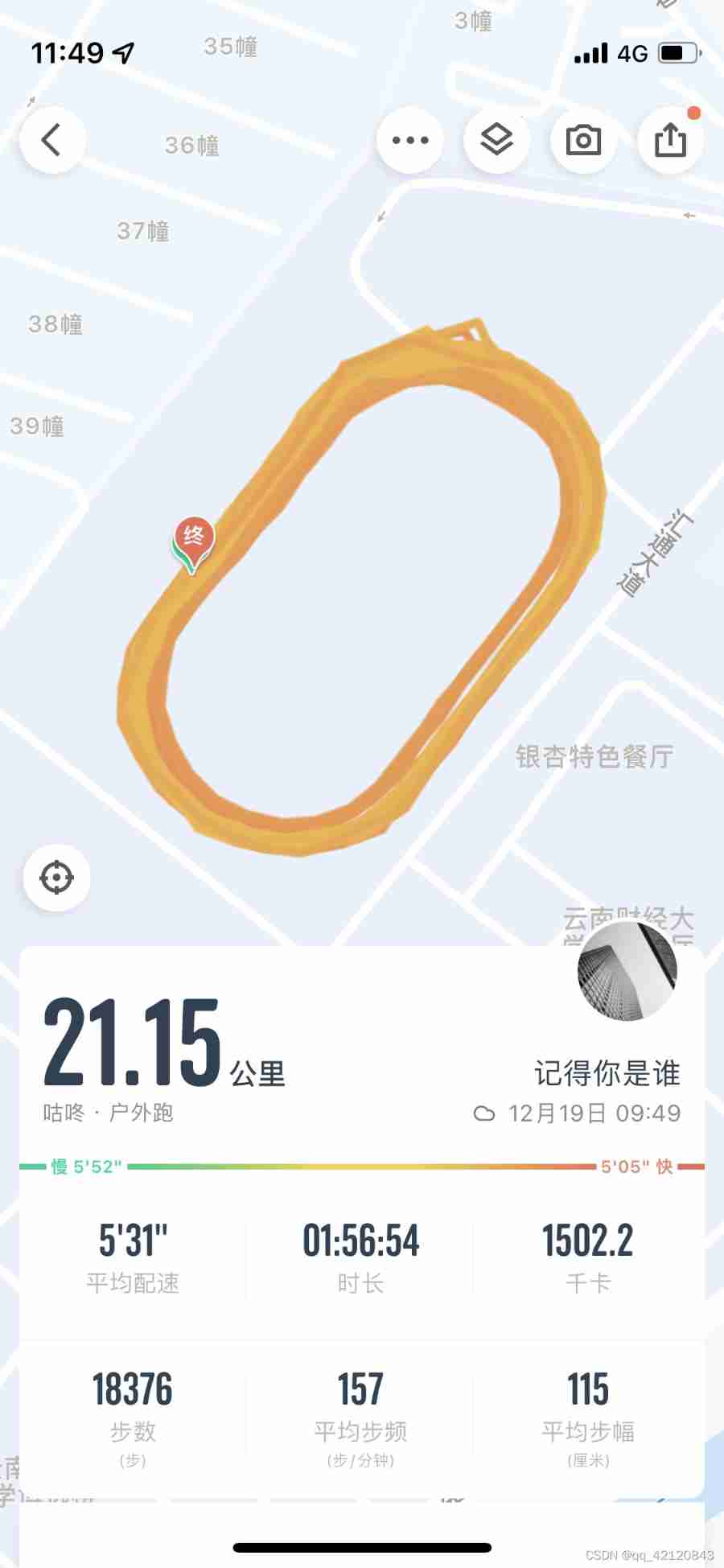
2021 summary and 2022 outlook
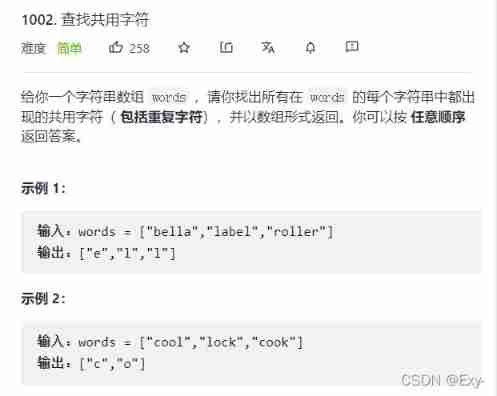
Force buckle 1002 Find common characters
![[untitled]](/img/f9/18b85ad17d4c560f2b9d95a53ee72a.jpg)
[untitled]

Still cannot find RPC dispatcher table failed to connect in virtual KD
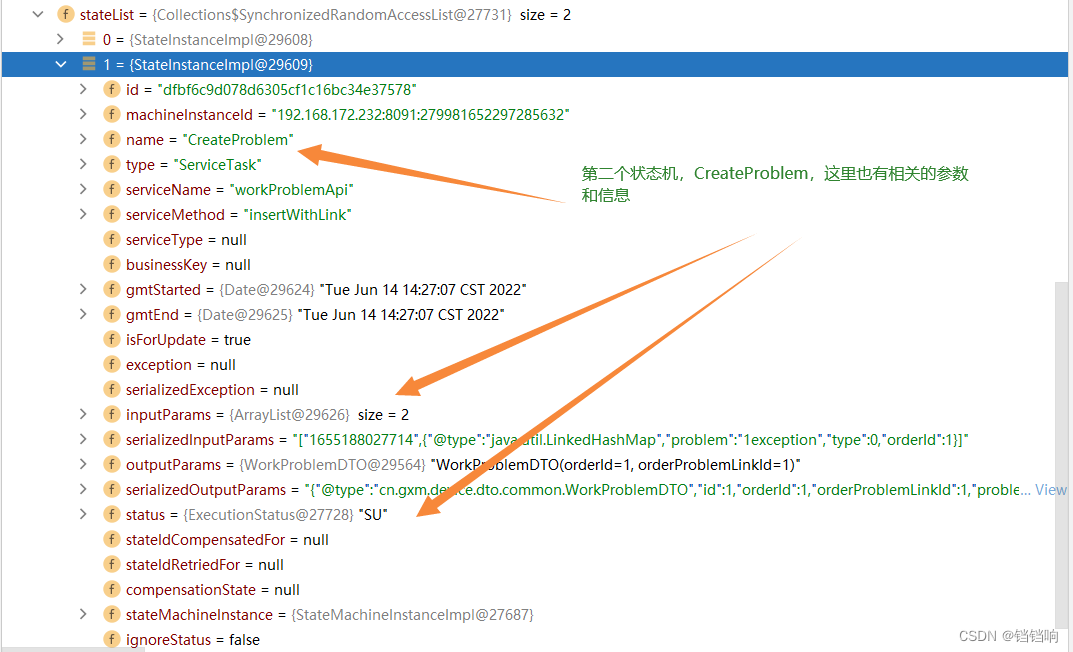
Seata 1.3.0 four modes to solve distributed transactions (at, TCC, Saga, XA)
![[OneNote] can't connect to the network and can't sync the problem](/img/28/9a02b1da0f43889989a9539c9fb6b6.png)
[OneNote] can't connect to the network and can't sync the problem
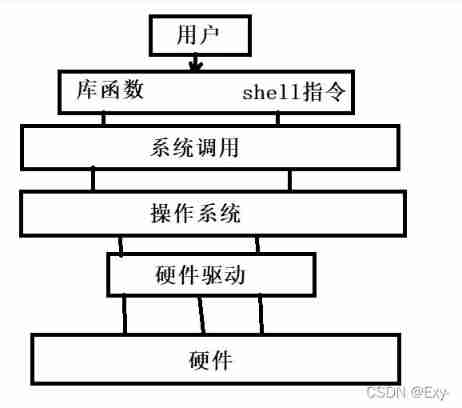
Basic knowledge of process (orphan, zombie process)
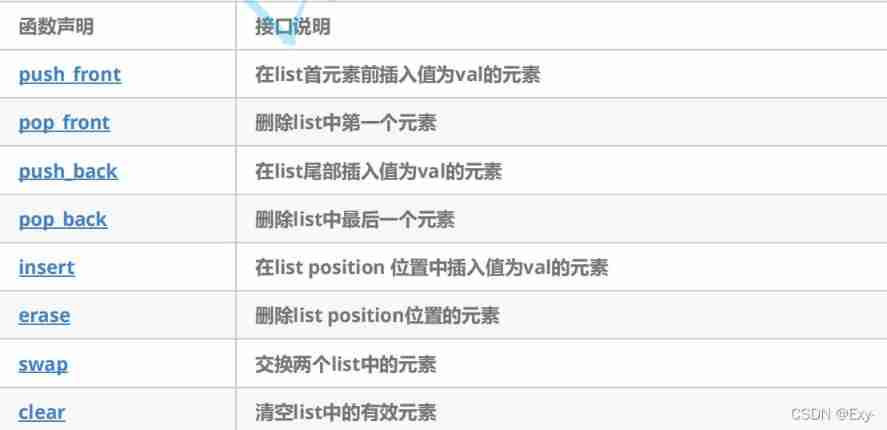
The use of list and Its Simulation Implementation

Wallhaven壁纸桌面版
随机推荐
VIM命令模式与输入模式切换
Project ERROR: Unknown module(s) in QT: core gui
测试优惠券要怎么写测试用例?
[pytorch 07] hands on deep learning chapter_ Preliminaries/ndarray exercises hands-on version
Opencv installation and environment configuration - vs2017
MPX plug-in
Multithreaded application (thread pool, singleton mode)
基于Retrofit框架的金山API翻译功能案例
Wallhaven wallpaper desktop version
关于在云服务器上(这里用腾讯云)安装mysql8.0并使本地可以远程连接的方法
PostgreSQL中的表复制
Kitex 重试机制
如何在博客中添加Aplayer音乐播放器
[pyqt] the cellwidget in tablewidget uses signal and slot mechanism
Unity downloads files through the server address
Simple and easy to modify spring frame components
Deeply understand the characteristics of database transaction isolation
Ffmpeg record a video command from RTSP
What if copying is prohibited?
2022.7.6DAY598